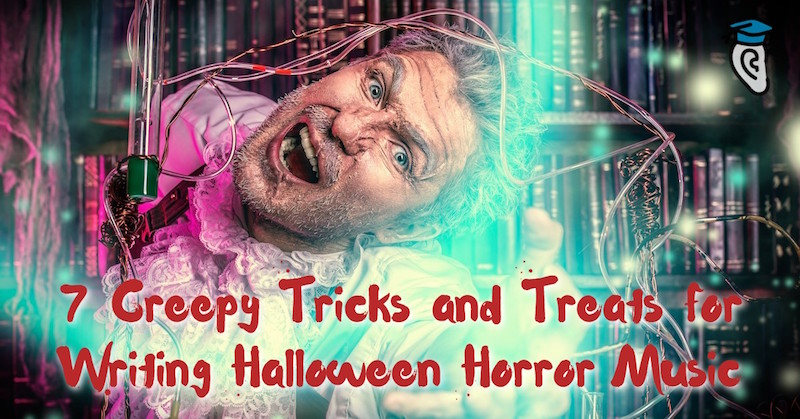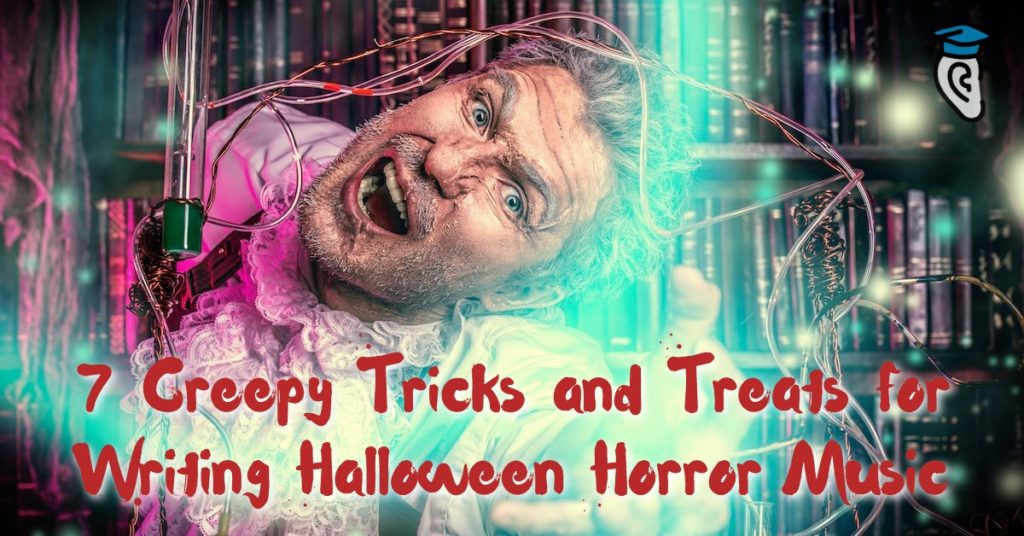Halloween brings out the scary and creepy in music. Learning how to write music that is perfect for Halloween horror is easy and a lot of fun! Follow these seven simple tips about how you can use sound effects, instrumentation, harmony and more to create a convincing scary song this Halloween.

Before we start talking about how to write super freaky Halloween music, let’s work on your listening skills. Listen to the sample audio Frankenstein’s Dreamscape. As you listen, use your ears to jot down just a few of the spooky characteristics in this haunting track.
Listen for:
- Melodies
- Sound Effects
- Instrumentation
- Harmony
Do the sounds remind you of other creepy soundtracks from favorite films or classical music?
Do any of the sounds remind you of monsters from your favorite scary books?
Can you identify the musical elements that make this track perfect for Halloween?
Halloween Music Tip 1: Creepy Vocal Effects
In this soundtrack, you hear creepy female voices whisper words like “demon” and “evil” throughout, creating a sonic environment that reminds you of your worst nightmare.
Create the same effect by using a sample library like Easy West Symphonic Choirs (which has a wide array of creepy vocal effects), vocals from a sound effects library, or simply record your own freaky voices. Think “ghost” and try to emulate the scary sounds you might hear in a haunted house.
You will hear these female whispers in your ear at the beginning and end of Frankenstein’s Dreamscape.
Halloween Music Tip 2: Add a Mournful Violin
In several adaptations of Mary Shelley’s Frankenstein, there are passages where Frankenstein’s Creature is comforted by the playing of a violin. Other classic monsters have also been associated with the violin—like Dracula: perhaps as a musical nod to his Transylvanian roots.
By adding in a mournful violin, the soundtrack brings to mind references in literature and film in the mind of the listener. Setting the solo violin in an eerie soundscape adds to the mystery.
The violin solo below is originally from the comedy Young Frankenstein by Mel Brooks and starring the amazing Gene Wilder as Dr. Frankenstein. Here musician Erutan has modernized the original track with a catchy viral video but manages to retain its original haunting feel.
Halloween Music Tip 3: The Foreboding Choir
At [1:23] in Frankenstein Dreamscape, the pace picks up with the drum set and a haunting choir singing in a minor key. Create the same audio effect with choir samples from your library.
If you have access to a few good singers, you can record them singing different parts. Use panning, reverb, and divisi harmony to make a few singers (or even one singer) sound like a full choir. Support your live vocals with a choir patch underneath to add fullness.
Go to [1:23] in Frankenstein’s Dreamscape to hear the haunting choir.
In Libertaria: The Virtual Opera, the multiple vocal takes from one singer (Perry Cook) were used to create a full choir sound. The composer used panning, reverb, and other effects to make one cast member sound like a full soldier choir.
Halloween Music Tip 4: Back to Bach
The sound of a traditional church organ has become synonymous with creepy Halloween music thanks to Bach’s Toccata and Fugue in D Minor. This work, although hundreds of years old, has been associated with the macabre in film and contemporary music. Add in a creepy cathedral organ to your soundtrack to bring out classical fright.
Halloween Music Tip 5: Sound Effects
In Frankenstein’s Dreamscape you hear the sound of wolves (werewolves maybe) in the distance, footsteps running in the muck of a forest, scary whispers, haunting laughter and more. Adding in sound effects can be an easy and fun way to add fright to your soundtrack.
In this excerpt, you will only hear the Sound FX being used.
- What different sounds do you hear?
- How is panning used in the footsteps?
- What effects are used on the evil laugh to make it more ominous?
Watch out for going over the top in the cheesiness factor! Frankenstein’s Dreamscape incorporates quite a few fun sound effects because it is meant to be a quirky Halloween song.
For a professional horror film project, you want to minimize sound effects (or record your own original effects) or emulate sound effects with instruments instead. For example, playing piano strings sounds like eerie spirits and a drumbeat sounds like a heartbeat or slamming door.
Halloween Music Tip 6: Telling a Story through Sound
When you add in classical creepy music and sound effects to your music, you might want to experiment with telling a story with that music. Growing up near Disney World as a child, part of my musical inspiration for Frankenstein’s Dreamscape came from the creepy narrative from Disney’s Haunted Mansion Ride. You don’t need to have an actual narrator throughout your song, but you can emphasize the story through sound and help the listener imagine what is happening.
Listen to the narrative below. How do the creepy narration, sound effects, and music work together?
Halloween Music Tip 7: Minor Harmonies
It goes without saying that adding dissonance and minor chords to your music will make it more unsettling to the Western ear. Accustomed to traditional tonal harmony, most of the Western world has a very specific idea as to what is pleasing to the ear and what is not. Because of this, the ideas of tension and release in music are exemplified in the use of specific harmonies, like major scales vs. minor scales.
As you explore classical music from the last hundred years and move into global music that experiments with microtones and different musical systems, you will find that dissonance and tension mean something different depending on geographic area.
In a nutshell, this means that when you write music in minor, your song takes on a distinctly creepy tone. Check out Chase Holfelder’s minor version of Over the Rainbow from the Wizard of Oz. The uplifting tune becomes distinctly macabre in this arrangement.
Spooky! Don’t be surprised that when you dump your sack of trick-or-treats, you find a few cathedral organs, minor keys, and a mournful violin or two. Feed your urge to write creepy melodies and haunting audio. Reach out and scare someone on this happy, haunted Halloween!







